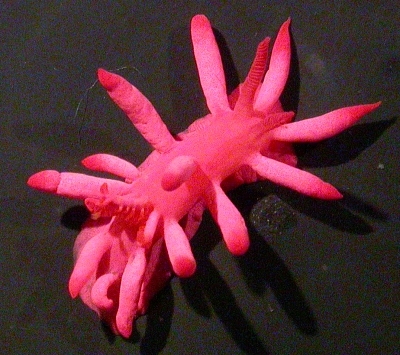
Okenia atkinsonorum
Rudman, 2007
Order: NUDIBRANCHIA
Suborder: DORIDINA
Superfamily: ANADORIDOIDEA
Family: Goniodorididae
DISTRIBUTION
Known at present from New South Wales, southeastern Australia and probably nthn New Zealand [see message #21216 ]
PHOTO
The Pipeline, west side of Nelson Bay, Port Stephens, New South Wales, Australia, on Pleurotoichus clathratus, 11 m, 11 June 2005, 13-15 mm long alive. AM C 445669. Upper: Photo: Des Beechey. Lower left: feeding on on Pleurotoichus clathratus. Photo: L. & D. Atkinson. Lower right: radula teeth. Photo: Alison Miller.
The animal is bright pink except for tips of the mantle processes, gills and rhinophores, which are a deeper, redder shade of the same colour. The body has a relatively low profile and lacks a mantle ridge, but its position is indicated by up to seven large mantle papillae on each side. The lateral pap In body shape, O. hallucigenia differs from the other two species in its elongate and high body profile and the distinct and separate oral veil.illae are usually arranged in pairs opposite one another, but there can be one or two extra, and unmatching, on either side. Some papillae are bluntly rounded, while others have a pointed tip. There are usually two dorsal mantle papillae, in the midline, one in front of gills, one behind. There are usually five gills arranged in an arc around the anal papilla, each gill inserted separately. From above the head is indistinguishable from the foot but ventrally there is a distinct V-shaped groove differentiating the head and the foot.
The radular teeth of O. atkinsorum have some similarities to those of O. stellata in having a long elongate first lateral tooth but the teeth differ in shape and size. In O. stellata these teeth are simple rod-like structures, 800 microns in length, with a groove along one edge, while in O. atkinsonorum the teeth have a wide base, and taper to a tip which bears a subapical harpoon-like flange. Although more elongate than the teeth of most species of Okenia, they are only about 300 microns in length, so much shorter than those of O. stellata. In colour, O. atkinsonorum and O. hallucigenia are very similar, being a uniform pink except for the tips of the dorsal tentacles, papillae and rhinophores, which are a deeper reddish pink. Neither species have the red lines which form part of the colour pattern of O. stellata.
O. hallucigenia differs from the other two species in its body shape, and the shape and small size of its radula teeth. All three species feed on the bryozoan Pleurotoichus clathratus. This species is named after Leanne & David Atkinson who have observed this animal in the Port Stephens region, from the west side of Nelson Bay to Halifax Park, for over 15 years. They are regular contributors to the Forum and have made many valuable contributions to my research.
Note: This species has been misidentified by me as O. hallucigenia in earlier messages to the Forum.
- Rudman, W.B. (2007) Two new species of Okenia (Gastropoda: Nudibranchia: Goniodorididae) from eastern Australia and Tanzania. Zootaxa, 1657: 57–67.
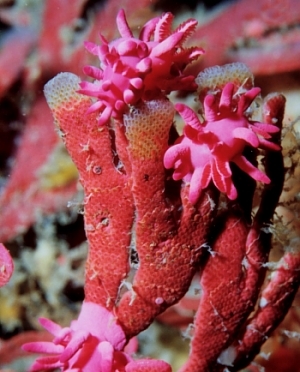
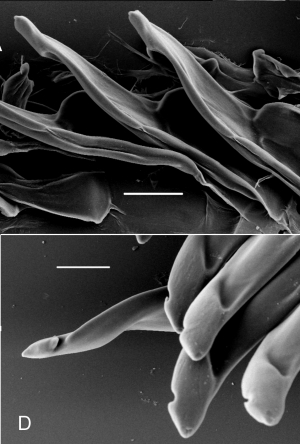
Rudman, W.B., 2007 (December 10) Okenia atkinsonorum Rudman, 2007. [In] Sea Slug Forum. Australian Museum, Sydney. Available from http://www.seaslugforum.net/find/okenatki
Related messages
Re: Okenia atkinsonorum - another pink species
January 31, 2008
From: Leanne & David Atkinson
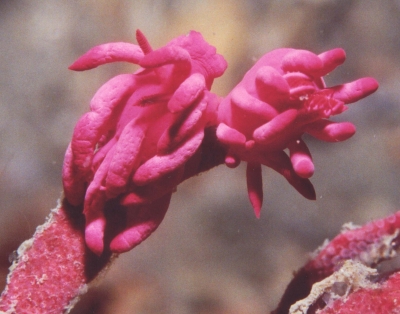
Concerning message #21273:
Dear Bill,
Thankyou for naming Okenia atkinsonorum after us, it is a great honour. Here are some more photos to add to your visual record of O. atkinsonorum on the forum.
There are two photos of them mating, one taken at The Pipeline and one taken at Fly Point. Both are popular dive sites in Port Stephens. They are found all year round throughout Port Stephens and the nearby islands wherever their food bryozoan is found. We found one at Looking Glass at Broughton Island just north of Port Stephens at the weekend. We have also included a photo of the foot.
Locality: Port Stephens, 12 to 14 metres, New South Wales, Australia, Pacific, June 2005 and 24 December 2005, Sandy bottom with scattered bryozoans, soft corals, sponges, ascidians and gorgonians. Length: approximately 8mm. Photographer: Leanne and David Atkinson.
We hope you enjoy your holiday and have a well deserved rest.
Best wishes,
Leanne & David Atkinson
atk@hunterlink.net.au
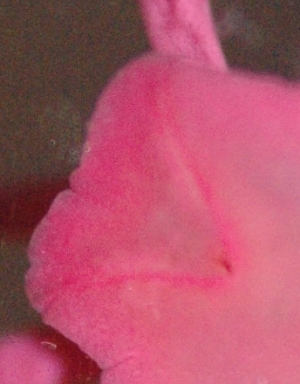
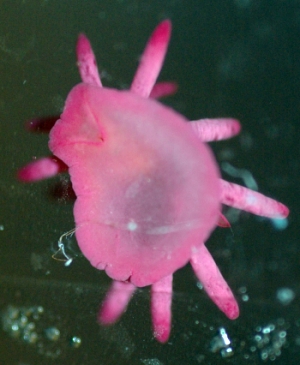
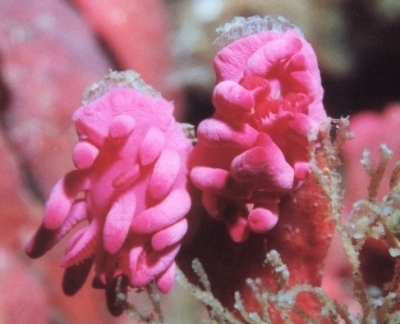
Thanks Leanne and David,
I particularly like the photo of the underside showing the V-shaped mark which marks where the head and the foot have merged. The mouth is the small dark mark at the bottom of the V.
I am glad I could thasnk you in this way for your help in sorting out this little mystery. Now that I am no longer 'fooled' by this third pink species which I used to think was Okenia hallucigenia it will be interesting to see how long before O hallucigeniais found again in Port Stephens. The last definite record I know of it from there is my photo from July 1986.
Best wishes,
Bill Rudman
Okenia atkinsonorum? from New Zealand
December 10, 2007
From: Ian Skipworth

Hi Bill
Further to my previous message #12958, attached a couple of photos of my second find of this beautiful wee slug.
Locality: Poor Knights Islands, 25 m, New Zealand, Pacific Ocean, 17 November 2007, Rocky reef. Length: 13 mm. Photographer: Ian Skipworth.
Cheers
Ian
ianskip@xtra.co.nz


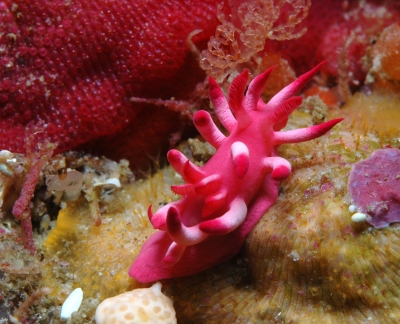
Dear Ian,
Thanks very much for these excellent photos. As luck would have it they arrived just after the final proofs of a paper describing a new species from eastern Australia - Okenia atkinsonorum - were returned to the publisher. I am pretty sure your animal is the same species, but because we now have 3 pink species in eastern Australia which are quite difficult to tell apart in photos, I would like to see the anatomy of your animal before I can be 100% positive - but on external shape and colour I can see no differences.
When you sent me photos before [messages #12958, #13019 ] I realised it was neither O. hallucigenia nor O. stellata but did not realise we had a third pink species in New South Wales at that time. At the time, I checked with Dennis Gordon, a bryozoan expert, who identified the pink bryozoan your animals were on to be a eurystomellid, which is the family of bryozoans that the Japanese O. hiroi and the Californian O. rosacea feed on, rather than the euthyrisellids that the eastern Australian ones eat. From the bryozoan identification and general shape, your earlier photos suggested a similarity to O. hiroi. Assuming your present photos are of the same species as your earlier ones, they show the same number and arrangement of dorsal papillae as O. atkinsonorum and as in that species, some of the papillae have rounded tips and others have pointed tips.
The only puzzle, is that in eastern Australia O. atkinsonorum feeds on Pleurotoichus clathratus [Euthyrisellidae] while your animal, from your earlier photos, feeds on a eurystomellid. Of course its possible that one species can feed on bryozoans from more than one family, but it has not been recorded before for any other of these pink species.
I checked the identity of the reddish bryozoan in your present photos with Dennis Gordon and he doesn't think it's either a eurystomellid or a euthyrisellid. As you mentioned that the slug was crawling along quite quickly it is probably just a coincidence it was passing a red bryozoan when you took your photos. Thanks again for sending in the photos, I am going to identify it as O. atkinsonorum, with the slight hesitation I have discussed above.
Best wishes,
Bill Rudman
More photos of Okenia atkinsonorum
December 10, 2007
From: Bill Rudman
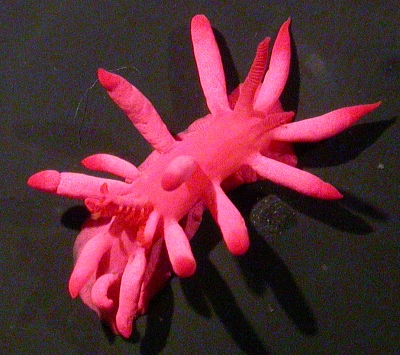
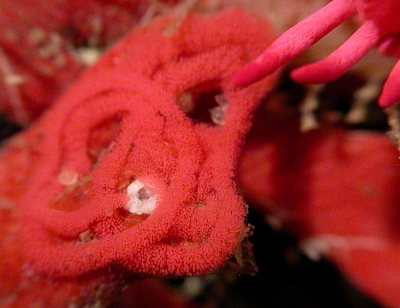
To complement my earlier message [#21273] on Okenia atkinsonorum here are some photos of the specimens sent to me by Leanne & David Atkinson. Fortunately an associate, Des Beechey, was available with camera when the specimens arrived and kindly took these photos for me.
Locality: The Pipeline, west side of Nelson Bay, Port Stephens, New South Wales, Australia, on Pleurotoichus clathratus, 11 m, 11 June 2005, 13-15 mm long alive, AM C445669. Collectors: Leanne & David Atkinson. Photos: Des Beechey.
Bill Rudman
Rudman, W.B., 2007 (Dec 10) More photos of Okenia atkinsonorum. [Message in] Sea Slug Forum. Australian Museum, Sydney. Available from http://www.seaslugforum.net/find/21274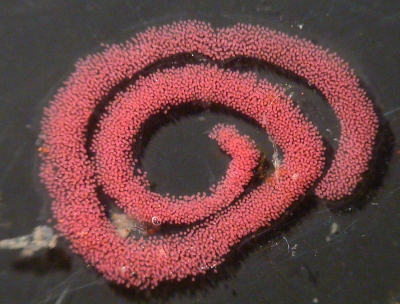
Photo of egg ribbon laid in a dish. Usually the egg ribbons is laid on their bryozoan food and as in the middle photo, does not appear as such a regular spiral. [long diameter of spiral = 9 mm].
Rudman, W.B., 2007 (Dec 10). Comment on More photos of Okenia atkinsonorum by Bill Rudman. [Message in] Sea Slug Forum. Australian Museum, Sydney. Available from http://www.seaslugforum.net/find/21274Okenia atkinsonorum - another pink species
December 10, 2007
From: Bill Rudman
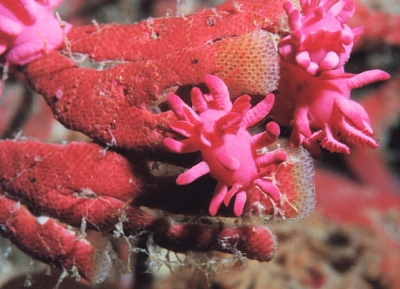
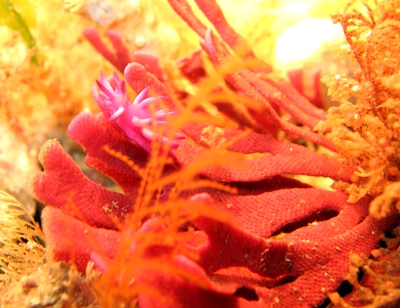
Within a few days of publishing descriptions of two new pink species of Okenia, both of which feed on the bryozoan Pleurotoichus clathratus [see Rudman, 2004], I received a message to the Forum concerning a pink Okenia from the mouth of Botany Bay, Sydney [message #13723]. I automatically identified it as one of those new species, O. hallucigenia, which differed in colour and anatomy from the other, O. stellata . Some days later I began to have serious doubts about whether or not it was either of the new species, even though it was pink and like the other two fed on the same bryozoan.
One of the photos showed that the number of lateral processes was like neither species, so I asked the photographers to see if they could collect a few specimens. Despite their best efforts and the help of their dive club we did not find any specimens, but by then I had realised that all the other messages on the Forum which I had identified as O. hallucigenia were most probably this new species. Fortunately Leanne & David Atkinson were able to collect a few specimens for me from Port Stephens where there appears to be a permanent population. Sure enough, the internal anatomy, in particular the radula, shows that this is a third pink species living in eastern Australia and feeding on the bryozoan Pleurotoichus clathratus.
Locality: The Pipeline, west side of Nelson Bay, Port Stephens, New South Wales, Australia, on Pleurotoichus clathratus, 11 m, 11 June 2005, 13-15 mm long alive, AM C445669. Photos: Leanne & David Atkinson.
I have had great pleasure in naming it Okenia atkinsonorum in recognition of Leanne & David Atkinson's contributions to my research and their continuing contributions to the Forum. The description is published in Zootaxa. I have included here a few more of their photographs.
This week Ian Skipworth sent me more photos [message #21216 ] of the pink Okenia from northern New Zealand which I had previously suggested look similar to Okenia hiroi. In his latest photos it seems clear that it is most probably O. atkinsonorum as well, but as I have been mistaken before by photos of these pink species, I am now hesitant to be 100% sure without looking at the radula of this New Zealand animal.
-
Rudman, W. B. (2004) Further species of the opisthobranch genus Okenia (Nudibranchia: Goniodorididae) from the Indo-West Pacific. Zootaxa, 695, 1-70.
-
Rudman, W.B. (2007) Two new species of Okenia (Gastropoda: Nudibranchia: Goniodorididae) from eastern Australia and Tanzania. Zootaxa, 1657: 57–67.
Bill Rudman
Rudman, W.B., 2007 (Dec 10) Okenia atkinsonorum - another pink species. [Message in] Sea Slug Forum. Australian Museum, Sydney. Available from http://www.seaslugforum.net/find/21273
Locality: The Pipeline, west side of Nelson Bay, Port Stephens, New South Wales, Australia, on Pleurotoichus clathratus, 11 m, 11 June 2005, 13-15 mm long alive, AM C445669. Photos: Leanne & David Atkinson.
In this photo we can clearly see how the tissue has been eaten off the tips of the branches of the bryozoan colony.
Rudman, W.B., 2007 (Dec 10). Comment on Okenia atkinsonorum - another pink species by Bill Rudman. [Message in] Sea Slug Forum. Australian Museum, Sydney. Available from http://www.seaslugforum.net/find/21273Okenia hallucigenia from Bare Island, Sydney
May 9, 2005
From: R. Fea & J. Coombs
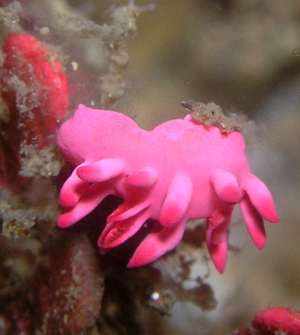
Note added 10 Dec. 2007: This species has been identified as Okenia atkinsonorum [see message #21273].
Dear Dr Rudman,
Could you identify this nudibranch from Bare Island please. It was taken at Bare Island Deep Wall (at about 15 m) and was no more than 5mm long. We thought it might have been a red-lined flabellina but we're not sure about it's uniform rosy appearance.
Locality: Bare Island, Botany Bay, Sydney, NSW, Australia. Depth: 6 m and 15 m. Length: 5 mm - 10 mm. 04 February 2005, 08 May 2005. Sponges, boulders. Photographer: Roxanne Fea
Many thanks,
Roxanne Fea & Jason Coombs
roxannef@mgnsw.org.au
Fea, R. & Coombs, J., 2005 (May 9) Okenia hallucigenia from Bare Island, Sydney. [Message in] Sea Slug Forum. Australian Museum, Sydney. Available from http://www.seaslugforum.net/find/13723
Dear Roxanne and Jason,
This is Okenia hallucigenia which is usually found on, or near, the pinkish red bryozoan colony, Pleurotoichus clathratus, on which it feeds. The reddish plant-like growth in your photo is the bryozoan.
Best wishes,
Bill Rudman
Re: Okenia cf. hiroi from New Zealand
January 26, 2005
From: Ian Skipworth
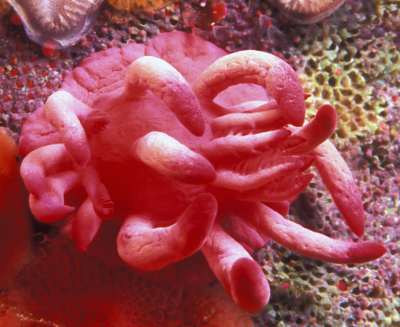

Note added 10 Dec. 2007: This species has been identified as most probably Okenia atkinsonorum [see message #21273].
Hi Bill
Thanks very much for your reply to my message [#12958]. I have 6 shots of the slug but they're all fairly similar. The attached images are different shots from the one I sent you before and show the whole frame. I was in under the Ecklonia (kelp) canopy when I took these.
Glad you had a good holiday in NZ.
Thanks again
Ian
ian@ianskipworth.com
Skipworth, I., 2005 (Jan 26) Re: Okenia cf. hiroi from New Zealand. [Message in] Sea Slug Forum. Australian Museum, Sydney. Available from http://www.seaslugforum.net/find/13019Dear Ian,
Your new photos suggest your animal is very similar to the northwestern Pacific species Okenia hiroi. We would need to examine its anatomy to be 100% sure, but it appears identical in colour and very similar in shape to Yukari Sato's photos of animals from Tsuruga Bay, Japan [see message #11399]. The only obvious external difference I can see is that usually in Okenia hiroi the mid dorsal mantle papilla is nearer the gills, and there are a pair of papillae just in front of the gills, and slightly behind the mid dorsal mantle papilla.
Your photos clearly show the encrusting bryozoan on which it has been feeding. Whether it is a new species or not, it is indeed a new record from New Zealand.
Best wishes,
Bill Rudman
Okenia hiroi? from New Zealand
January 25, 2005
From: Ian Skipworth
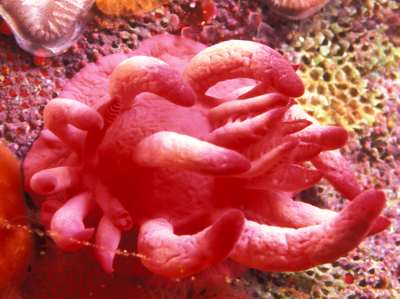
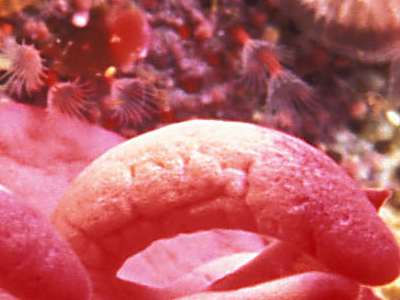
Note added 10 Dec. 2007: This species has been identified as most probably Okenia atkinsonorum [see message #21273].
Hi Bill
I hope you don't mind another request for a slug ID. Over the last couple of weeks I have been looking particularly for small stuff and have found several slugs which I haven't seen before.
Locality: Poor Knights Islands, NE New Zealand. Depth: 10m
Length: 12mm. 15 January 2005, Rocky reef.
Photographer: Ian Skipworth
This is an odd one. When I was photographing it the rhinophores and gills weren't at all distinct and I wasn't sure it was a nudibranch. It was in about 10m of water and is about 12mm long.
Regards
Ian
ian@ianskipworth.com
Skipworth, I., 2005 (Jan 25) Okenia hiroi? from New Zealand . [Message in] Sea Slug Forum. Australian Museum, Sydney. Available from http://www.seaslugforum.net/find/12958Dear Ian,
I certainly don't mind answering questions like this one!. This is a species of Okenia, and I am pretty sure it is Okenia hiroi, a species known only from the NW Pacific (China, Korea, Japan). If it is in fact that species its presence in New Zealand is almost certainly a result of shipping. Species of Okenia feed on bryozoans, and those species we know about, are very particular in which bryozans they eat, so it would be nice to know what bryozoan your animal was feeding on. If you have further photos showing the slug from a different aspect, and the bryozoan in more detail, I would be very interested in seeing them. I have included a close-up from your photo to show a few of the zooids from the undamaged part of the bryozoan colony
Best wishes,
Bill Rudman
Hopkinsia sp. laying eggs
March 4, 2003
From: Leanne Atkinson
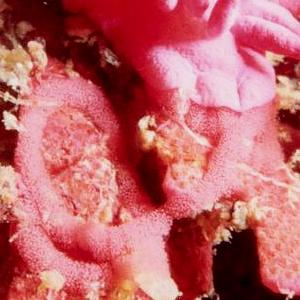
Note added 10 Dec. 2007: This species has been identified as Okenia atkinsonorum [see message #21273].
Dear Bill,
I know my husband David sent you a picture of the eggs of this species before but there didn't seem to be any in the collection of them actually laying eggs. Here are two that I have taken.
Location: " The Pink Wall ",Halifax Sponge Gardens, Marine Reserve, Port Stephens, NSW, Australia.
Date: January 2001
Depth: 20m
Daytime, high tide.
Regards,
Leanne Atkinson.
atk@hunterlink.net.au
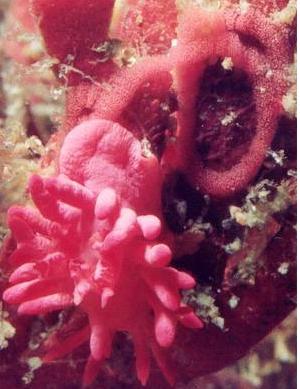
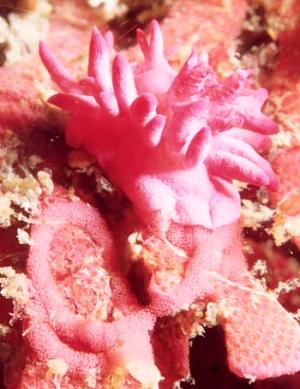
Thanks Leanne,
A very valuable addition
Bill Rudman
Hopkinsia from Sydney
February 8, 2003
From: Allan Saben
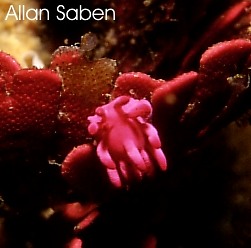
Note added 10 Dec. 2007: This species has been identified as Okenia atkinsonorum [see message #21273].
Could you please identify this species.
Taken at Henry's Head, Botany Bay, Sydney [New South Wales, Australia].
Depth: 20 meters. Macro 1:1
Many thanks
Allan
asaben@optusnet.com.au
Saben, A., 2003 (Feb 8) Hopkinsia from Sydney. [Message in] Sea Slug Forum. Australian Museum, Sydney. Available from http://www.seaslugforum.net/find/8402Dear Allan
This is a species of Hopkinsia which is found in eastern Asutralia.
Best wishes,
Bill Rudman
Observations on Hopkinsia sp.
January 29, 1999
From: David Atkinson
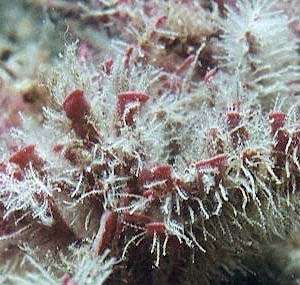
Note added 10 Dec. 2007: This species has been identified as Okenia atkinsonorum [see message #21273].
Hi Bill,
Hope you are well an the road to recovery and that you had a great festive season !
We had a dive at Halifax on Saturday and had a look at our "Pink Wall" (an 8m X 2m strip of pink bryozoan at 22m ). This is where we can always find our Hopkinsia sp nudis.
The bryozoan seems to have been largely overgrown by a Hydroid ?? which seems to make it unpalatable to Hopkinsia sp. Numbers are down on normal. The animals we did find were on the hydroid free areas.
One picture (BELOW RIGHT) shows mating ? Another (BELOW LEFT) shows Hopkinsia eggs in the top right corner of photo?
The other (TOP RIGHT) shows the bryozoan "infestation" with hydroid ? What is the pink bryozoan ?
David Atkinson
atkin@hunterlink.net.au
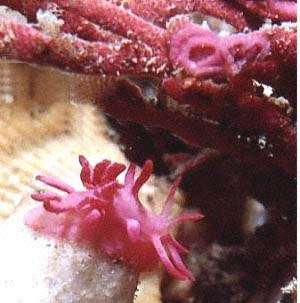
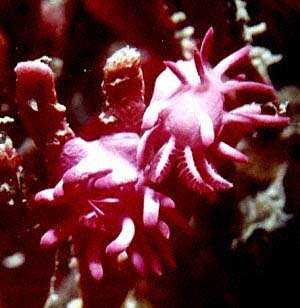
Dear David,
Yes I'm well and had a good Christmas break. Thanks for the interesting pictures. Yes the bryozoan is being overgrown by hydroids. This bryozoan often has hydroids growing on it, but usually just a few as in the photo at the top of the page. All sessile organisms (ones that are fixed and can't move away) in the sea have a problem with "fouling organisms" which are plants and animals which settle on and smother sessile organisms. Fouling organisms get their name because they are a major problem when they foul the bottom of boats. They often have very short lifecycles, growing rapidly to maturity. they settle on all bare surfaces.
Many sessile plants and animals have evolved mechanisms to keep fouling organisms at bay, through chemicals and special structures. This bryozoan clearly hasn't succeeded. Nudibranchs, even those that feed on cnidarians, are usually not immune to hydroid nematocysts, so it unlikely that Hopkinsia would be much use in clearing an area already overgrown with hydroids. Quite possibly the hydroids have affected the Hopkinsia population by preventing larval nudibranchs from settling out of the plankton, or by eating the larvae.
I am not sure that your two animals are mating. They have their reproductive apparatus on the right side of the body so during mating they need to be aligned so their right sides are touching. Your animals may be thinking about it but I don't think their right sides are together.
The pink bryozoan's name, Pleurotoichus clathratus, is at the top of the page. Thanks for this information. I don't think I have seen the egg mass of this species before.
Best wishes,
Bill Rudman.
Totally pink!
January 13, 1998
From: Bill Chambers

Note added 10 Dec. 2007: This species has been identified as Okenia atkinsonorum [see message #21273].
Attached file contains a photo of a pair of totally pink nudibranchs that a colleague of mine took in Nelson Bay, Port Stephens, New South Wales. We have scoured our (limited) sources with no success. Whilst I realise that full taxonomy entails more that a photo ID, if you could shed some light on our "new" species we would be very grateful. I am a SCUBA Instructor (& sometimes U/W photographer) on most weekends, and an amateur Nudi-phyle at other times... So I am always being questioned on "which one is this",
Thanks for your time.
Regards,
Bill Chambers.
chambers@fastlink.com.au
Chambers, B., 1998 (Jan 13) Totally pink!. [Message in] Sea Slug Forum. Australian Museum, Sydney. Available from http://www.seaslugforum.net/find/72Your nudibranch is a fairly common east coast (warm water) nudibranch which is at present unnamed...one of many. It is at present considered a species of Hopkinsia but there are few differences between that genus and the closely related genus Okenia. It feeds exclusively on the bryozoan you have photographed it on, Pleurotoichus clathratus. You can clearly see on your photo where the slugs have stripped the living tissue off the tips of the colony...Bill Rudman
Rudman, W.B., 1998 (Jan 13). Comment on Totally pink! by Bill Chambers. [Message in] Sea Slug Forum. Australian Museum, Sydney. Available from http://www.seaslugforum.net/find/72